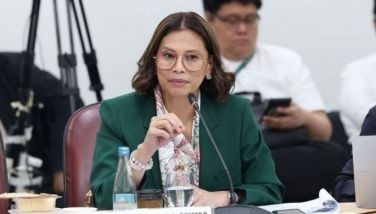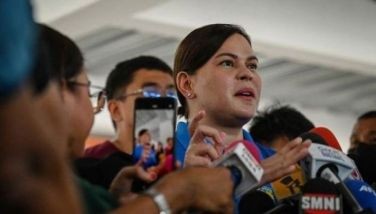Giant windmills energize Ilocos Norte
October 13, 2005 | 12:00am
BANGUI, Ilocos Norte (AFP) — When enormous windmills began appearing on a desolate stretch of the northern Philippine coast, locals were overjoyed rather than alarmed.
The steel contraptions, standing 23 stories high, were unlike anything impoverished families from Bangui Bay had ever seen. But they were enthusiastic nevertheless.
The 15 "giant electric fans" were bringing electricity to their homes for the first time.
"It was a joy to watch them being built," said 72-year-old Rosita Ridun, whose family earns less than P100 a day collecting pebbles on Bangui beach for sale to construction companies.
"My grandchildren described them as giant electric fans."
Standing in an arc in wind-lashed scrubland, the windmills, which started supplying electricity to 40 percent of Ilocos Norte in May, are the first source of clean energy introduced in the Philippines, a nation with 84 million people reliant on oil and gas.
Costing more than $48 million, the windmills, built by a private company with interest-free loans from the Danish government, can harness winds the strength of Hurricane "Katrina" which devastated the US Gulf Coast last month.
And as crude oil prices spike above $70 per barrel, interest in the windmills is growing. President Arroyo has ordered a reduction in fuel consumption and an investigation into possible alternative energy sources.
Consequently, government and state-owned power company officials are requesting the head of the Bangui Bay project, a Danish engineer, try and help them replicate these windmills throughout the country.
"Everybody wants to be a wind developer now," said engineer Niels Jacobsen, president and chief executive of the Northwind Power Development Corp.
Jacobsen started work on the 24.75-megawatt project in 1999 after meeting Ilocos Norte Gov. Ferdinand Marcos Jr., who was intent on fixing the patchy and low-voltage power supply to his region which lies on the northern tip of the country’s electricity grid.
Marcos was well aware of the potential of wind because his father and former president, Ferdinand Marcos, ordered a study into alternative energy in the 1970s amid the first global oil crisis.
The project itself was a logistical and engineering feat.
Each of the three rotor blades and its base, called a nacelle, weighs 104 tons with a diameter wider than the wingspan of an Airbus.
Three piers were built to land these structures and the tapered towers of steel measuring 4.2 meters thick at their base, which were shipped direct to Bangui Bay from Europe.
Piles were driven 12 meters into the leased land to support a 17-meter diameter base plate made up of 300 cubic meters of concrete on which each tower stands.
A substation and 57 kilometers of transmission lines were also built to deliver the electricity to the province’s local power cooperative. The cooperative buys this electricity at a discounted rate rather than sourcing more expensive electricity from a state-owned company.
But it’s not just the cooperative and locals who have benefited from the windmills. Northwind earned carbon credits from the project — and will sell $1.5 million worth of them over 10 years to the World Bank which manages a carbon credit fund as part of the Kyoto protocol to reduce greenhouse gases.
"We only sold a portion because, upon the advice of the World Bank, those carbon credits that we are still entitled to may be sold at a higher price later," said Ferdinand Dumlao, Northwind board chairman and treasurer.
Dumlao said the project cost translated to $2 million per megawatt of power generated, which is more than double the start-up cost of a normal power plant running on coal, oil or other conventional fuel.
Without the interest-free loans from the Danish International Development Agency (Danida), the project would have been unviable.
Danida provided $30 million in loans, payable over 10 years, and more than $10 million in grants, with the rest of the project cost coming from shareholders’ equity, including loans provided by the windmill and other equipment manufacturers.
"It’s not really going to make anyone rich," said Marcos, adding that Northwind investors would need between 20 and 25 years to earn money.
"Frankly, if there’s money to be made the province would have involved itself," he said.
However, Marcos does think the windmills will have other spin-offs, perhaps even becoming a permanent draw for tourists.
"Ilocos Norte is not really the spot where you would expect to see a high-tech operation like the windmill, so the people can hardly believe it. I can barely believe it myself," Marcos said.
"You even have tourists visiting the site which is great. It would make people more conscious about the availability of alternative power sources," he added.
The steel contraptions, standing 23 stories high, were unlike anything impoverished families from Bangui Bay had ever seen. But they were enthusiastic nevertheless.
The 15 "giant electric fans" were bringing electricity to their homes for the first time.
"It was a joy to watch them being built," said 72-year-old Rosita Ridun, whose family earns less than P100 a day collecting pebbles on Bangui beach for sale to construction companies.
"My grandchildren described them as giant electric fans."
Standing in an arc in wind-lashed scrubland, the windmills, which started supplying electricity to 40 percent of Ilocos Norte in May, are the first source of clean energy introduced in the Philippines, a nation with 84 million people reliant on oil and gas.
Costing more than $48 million, the windmills, built by a private company with interest-free loans from the Danish government, can harness winds the strength of Hurricane "Katrina" which devastated the US Gulf Coast last month.
And as crude oil prices spike above $70 per barrel, interest in the windmills is growing. President Arroyo has ordered a reduction in fuel consumption and an investigation into possible alternative energy sources.
Consequently, government and state-owned power company officials are requesting the head of the Bangui Bay project, a Danish engineer, try and help them replicate these windmills throughout the country.
"Everybody wants to be a wind developer now," said engineer Niels Jacobsen, president and chief executive of the Northwind Power Development Corp.
Jacobsen started work on the 24.75-megawatt project in 1999 after meeting Ilocos Norte Gov. Ferdinand Marcos Jr., who was intent on fixing the patchy and low-voltage power supply to his region which lies on the northern tip of the country’s electricity grid.
Marcos was well aware of the potential of wind because his father and former president, Ferdinand Marcos, ordered a study into alternative energy in the 1970s amid the first global oil crisis.
The project itself was a logistical and engineering feat.
Each of the three rotor blades and its base, called a nacelle, weighs 104 tons with a diameter wider than the wingspan of an Airbus.
Three piers were built to land these structures and the tapered towers of steel measuring 4.2 meters thick at their base, which were shipped direct to Bangui Bay from Europe.
Piles were driven 12 meters into the leased land to support a 17-meter diameter base plate made up of 300 cubic meters of concrete on which each tower stands.
A substation and 57 kilometers of transmission lines were also built to deliver the electricity to the province’s local power cooperative. The cooperative buys this electricity at a discounted rate rather than sourcing more expensive electricity from a state-owned company.
But it’s not just the cooperative and locals who have benefited from the windmills. Northwind earned carbon credits from the project — and will sell $1.5 million worth of them over 10 years to the World Bank which manages a carbon credit fund as part of the Kyoto protocol to reduce greenhouse gases.
"We only sold a portion because, upon the advice of the World Bank, those carbon credits that we are still entitled to may be sold at a higher price later," said Ferdinand Dumlao, Northwind board chairman and treasurer.
Dumlao said the project cost translated to $2 million per megawatt of power generated, which is more than double the start-up cost of a normal power plant running on coal, oil or other conventional fuel.
Without the interest-free loans from the Danish International Development Agency (Danida), the project would have been unviable.
Danida provided $30 million in loans, payable over 10 years, and more than $10 million in grants, with the rest of the project cost coming from shareholders’ equity, including loans provided by the windmill and other equipment manufacturers.
"It’s not really going to make anyone rich," said Marcos, adding that Northwind investors would need between 20 and 25 years to earn money.
"Frankly, if there’s money to be made the province would have involved itself," he said.
However, Marcos does think the windmills will have other spin-offs, perhaps even becoming a permanent draw for tourists.
"Ilocos Norte is not really the spot where you would expect to see a high-tech operation like the windmill, so the people can hardly believe it. I can barely believe it myself," Marcos said.
"You even have tourists visiting the site which is great. It would make people more conscious about the availability of alternative power sources," he added.
BrandSpace Articles
<
>
- Latest
- Trending
Trending
Latest






























